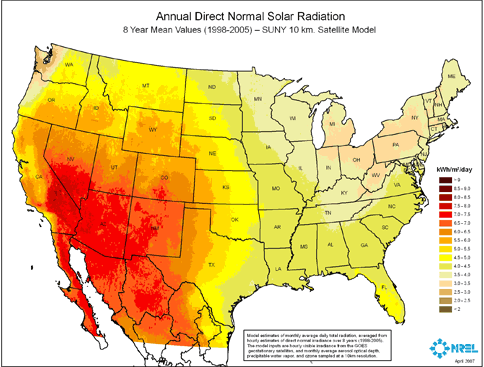Solar Photovoltaics
 Solar photovoltaic (PV) panels are efficient and sustainable sources of energy in southern Arizona and northern Sonora because there is abundant sunlight to produce energy. Solar potential varies by season, but in this region of the world, solar offers a viable alternative to fossil fuels for energy.
Solar photovoltaic (PV) panels are efficient and sustainable sources of energy in southern Arizona and northern Sonora because there is abundant sunlight to produce energy. Solar potential varies by season, but in this region of the world, solar offers a viable alternative to fossil fuels for energy.
Solar panels are made from multiple solar cells that have been combined to produce energy. Each cell consists of a semiconductor, usually silicone, that when struck by the sun’s UV rays will commence what is known as the photovoltaic effect. The photovoltaic effect is the creation of an electric current when a material is exposed to light. If controlled, that current can then be used to power appliances, turn on lights, and power other electrical devices.
More Details and Data
In 2017, responding to increased interest and investment in solar PV in southern Arizona and northern Sonora, individuals from both sides of the border came together with the specific goal of demonstrating the value and feasibility of small-scale solar energy production in Ambos Nogales (Nogales, Arizona and Nogales, Sonora) for reducing demand from traditional energy sources, offering a viable alternative as the region continues to grow, and lowering the cost of electricity for local users. Faculty, staff, and students from the University of Arizona’s Bureau of Applied Research in Anthropology (BARA), Technicians for Sustainability (TfS) of Tucson, Arizona, and the Centro de Capacitación para el Trabajador de la Industria plantel 118 (CECATI 118) of Nogales, Sonora came together to develop a demonstration project. The project was guided by an Advisory Board which included representatives from representatives from the Instituto Tecnológica de Nogales (ITN), the Colegio de Arquitectos, the Centro de Educación Industrial y de Servicios (CETIs 128), and the Universidad Tecnológica de Nogales (UTN). In the project’s second year, to address key questions about solar energy production and its relationship to weather conditions, the University of Arizona Climate Assessment Project of the Southwest (CLIMAS) joined the project.
Beyond their participation on the project Advisory Board, ITN and UTN played key roles in the project. At ITN, faculty and students from the Sustainable Development Class participated in workshops and created their own projects using alternative energy technologies, focusing primarily on passive solar and water heating. ITN also hosted an Encuentro in the fall of 2018 to bring faculty and students together with community members to explore solar technologies. At UTN, faculty from the Centro de Aplicación Tecnológica en Mecatrónica y Mantenimiento team (CEATEMM) helped organize workshops and conferences, and, through M.E. Verónica Alida Romo García, worked with BARA to examine specific educational and training needs to improve local capacity to maintain and expand household-scale solar PV. This included maintaining and expanding information and projects related to solar energy such as development of websites for sharing information and developing, administering, and analyzing data from surveys at UTN with the students in their Renewable Energies track and throughout the entire campus. In addition to being available to faculty and students from the participating universities and communities, the websites highlight relevant information for localities with geographic and climatic conditions similar to those of the Sonora-Arizona border region.
The project advisory board solicited bids and selected Acosta Fotovoltaica to install a solar PV system on the EcoCasa, located on the CECATI 118 campus. Installation was completed in October 2018, and in February 2019, with support from CLIMAS faculty, a weather station and air quality monitor were installed at the site to gather longitudinal data on environmental conditions, including temperature, precipitation, dewpoint/humidity, air quality (PM 2.5), and other weather conditions such as wind and barometric pressure. This environmental monitoring system was established to provide education and outreach opportunities regarding the impact of weather as it relates to solar energy production, and how weather events and seasonal variability affect solar potential in the Arizona-Sonora border region. This environmental monitoring system also was developed through and contributes to regional partnerships supported by CLIMAS and the Agnese Nelms Nelms Haury Program in Environment and Social Justice. Those partnerships are focused on connecting environmental data with outreach services for community engagement and decision-making support. Comprehensive solar PV and weather data are available at their respective data portals, as well as embedded content on this website (see below).